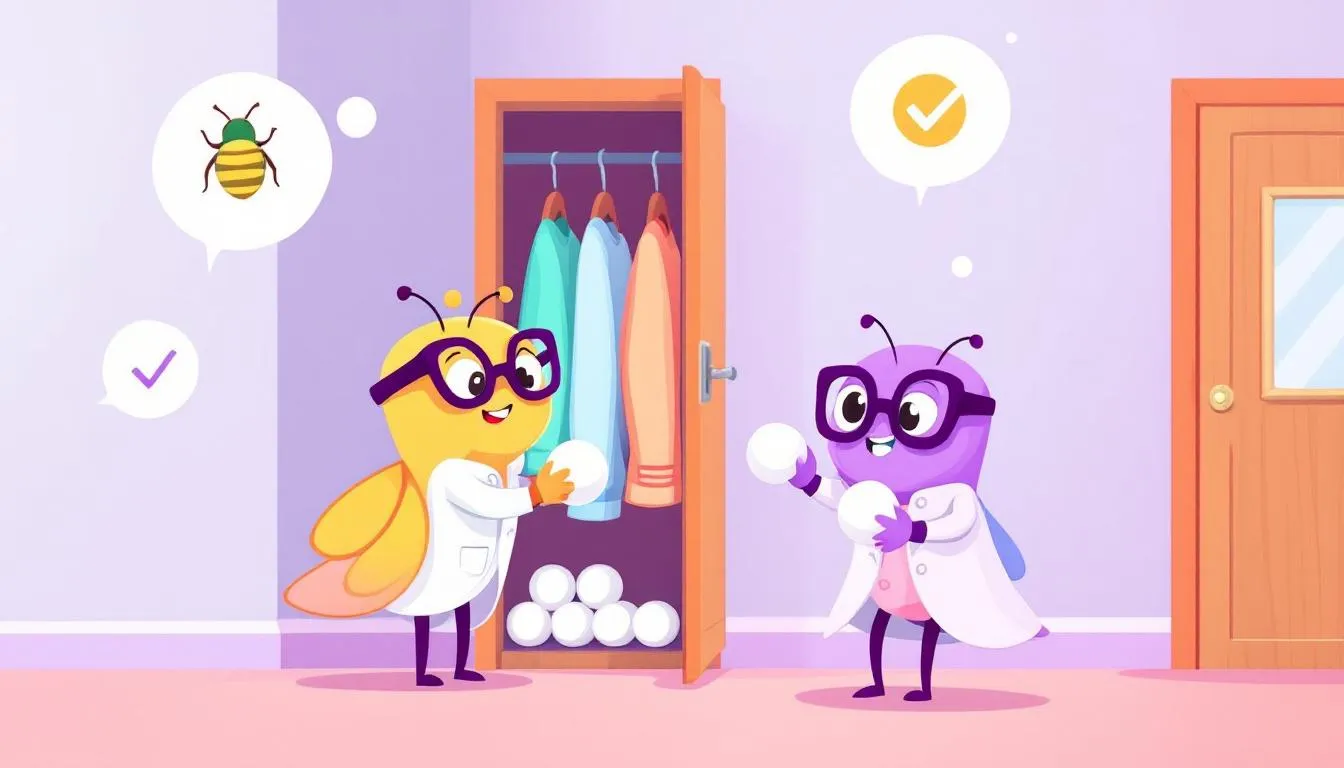Do mothballs deter mice? In short, no. Despite common belief, mothballs do not effectively deter mice. In this article, we’ll explain why “do moth balls deter mice,” discuss the risks, and explore better alternatives.
Do Moth Balls Repel Mice?
Many people believe that mothballs can repel mice, but this popular belief is largely unfounded. The idea that mothballs repel mice comes from their strong, pungent odor which is thought to be offensive to these rodents. However, while the smell might be unpleasant, it is not strong enough to provide reliable rodent control. In fact, some people suggest that mothballs keep mice away, but evidence supporting this claim is limited.
Understanding the working mechanism, effectiveness, and health risks of mothballs reveals why they are not ideal for mouse control.
How Mothballs Work
Mothballs contain active ingredients such as naphthalene and paradichlorobenzene, which are designed to control moths and other fabric pests. These chemicals work through a process called sublimation, where the solid mothball turns into toxic mothball fumes that are lethal to insects.
These vapors are effective in sealed environments like closets or storage containers, where they can build up to sufficient concentrations to kill moths and their larvae. However, this mechanism does not translate effectively to open spaces where mice are typically found, reducing the overall impact of mothballs on rodent control.
Are Mothballs Effective Against Mice?
While the active ingredient in mothballs, naphthalene, can deter mice to some extent, it is not strong enough to ensure their removal. Mice often do not leave even when they smell mothballs, as the odor is not powerful enough to drive them away effectively.
Relying on mothballs for rodent control isn’t reliable. Any initial repulsion they cause is short-lived, rendering them ineffective for long-term use, especially when it comes to repelling rodents.
Health Risks of Using Mothballs for Mice
Mothballs contain toxic chemicals that pose significant health risks to humans and pets if inhaled or ingested, including:
- Respiratory irritation
- Headaches
- Nausea
- Potential liver and kidney damage.
Furthermore, improper use of mothballs can lead to severe poisoning in pets and wildlife, and using them for rodent control is illegal as they are not intended for this purpose. The potential health hazards far outweigh the minimal benefits of using mothballs to deter mice.
Understanding Mothballs and Their Intended Use

Mothballs are mainly designed to eliminate pests that damage fabrics. This includes insects like clothes moths. These small, pungent spheres are designed to protect stored clothing and textiles from insect damage by releasing toxic vapors that kill moths and their larvae. However, a common misconception is that their strong odors might deter other pests as well.
This section will delve into what mothballs are made of, their proper use, and the potential consequences of misusing them for purposes like mouse control.
What Are Mothballs Made Of?
Mothballs are made of active ingredients such as naphthalene or paradichlorobenzene, which are chemicals known for their pest control properties. These substances are effective at killing moths and other fabric pests when used correctly.
Proper Use of Mothballs
For mothballs to work effectively, they must be used in sealed, airtight containers or spaces. This ensures that the toxic fumes can build up to a concentration high enough to kill fabric pests. In the U.S., mothballs are regulated by the Environmental Protection Agency (EPA) to ensure they are used safely and effectively.
Using mothballs outside these controlled settings, such as in open areas for mice repellent, is both ineffective and against EPA regulations.
Misuse of Mothballs
Using mothballs for mouse control is illegal and poses significant health and environmental risks. When used improperly, the toxic chemicals in mothballs can cause serious health issues, including headaches, nausea, respiratory irritation, and even carcinogenic effects.
Outdoor use of mothballs can contaminate soil and water, harmful to the ecosystem. The EPA regulates their use as a pesticide to prevent such misuse and protect public health and the environment.
Why Mothballs Fail to Deter Mice
Despite the common belief that mothballs can deter mice, their effectiveness is highly questionable. The odor of mothballs dissipates rapidly over time, reducing any protective barrier they might initially provide. Additionally, the concentration of active ingredients in mothballs is often too low to effectively repel mice.
This section will explore the reasons behind the failure of mothballs to deter mice, including the low concentration of active ingredients and the adaptability of mice.
Low Concentration of Active Ingredients
The amount of naphthalene present in mothballs is minimal and insufficient for effective mouse deterrence. This low concentration does not provide a strong enough odor to keep mice away.
Adaptability of Mice
Mice have a remarkable ability to adapt to strong odors, including those from chemical repellents like mothballs. Initially, the presence of potent smells might deter them, but over time their sense of smell acclimates, rendering the deterrent ineffective.
Due to their adaptability, mice can become accustomed to the smell of mothballs, diminishing the deterrent effect and making long-term control unlikely.
Environmental and Health Hazards
Outdoor use of mothballs can contaminate soil and water, harming the environment. Their vapors dissipate quickly, reducing effectiveness and causing potential ecological damage.
Mothballs should be kept away from food and preparation areas to prevent contamination and ingestion of toxic chemicals, underscoring the dangerous implications of improper use, especially when used in large quantities.
Safer Alternatives to Mothballs for Mouse Control

Safer and more effective mouse control alternatives include environmentally friendly commercial repellents, ultrasonic devices, and essential oil-based sprays, which do not pose health risks. The best repellent options are those that are both effective and safe, providing better alternatives.
This section will explore natural deterrents, physical barriers, and professional pest control services as viable alternatives to using mothballs to deter pests.
Natural Deterrents
Natural deterrents that can be effective in repelling mice include:
- Peppermint oil
- Ammonia
- Cinnamon
- Vinegar
Essential oils and other strong smelling substance create an environment that mice dislike, reducing their presence. Mice hate these strong-smelling substances.
Dryer sheets may repel mice but are not a long-term solution and should be used alongside other methods.
Physical Barriers
Sealing entry points with materials like steel wool prevents infestations, as mice cannot chew through steel wool, effectively blocking their access to seal entry points.
Professional Pest Control
Professional pest control services offer integrated pest management, combining prevention and intervention for effective control, often proving more effective than DIY methods.
Using professional pest control ensures comprehensive and long-term mouse management, reducing the likelihood of future infestations.
Preventive Measures to Keep Mice Away

Preventing mice from entering your home is the best strategy for rodent control, keeping mice out involves a combination of maintaining cleanliness, reducing clutter, and conducting regular home inspections to rid your space of potential entry points.
Eliminating food sources, sealing entry points, and maintaining tidy living spaces creates an environment less attractive to mice. Here are detailed preventive measures to keep them away.
Maintaining Cleanliness
Keeping your home clean is essential for rodent control. Store food in sealed containers to prevent access, and maintain regular cleaning practices to eliminate food remnants that attract mice.
Keeping outdoor areas tidy by removing debris and clutter deters mice from nesting around your home. A clean environment is less inviting to mice, making control easier.
Reducing Clutter
Reducing clutter eliminates potential nesting areas for mice and helps you get rid of any attractants. Properly trimmed shrubs and bushes discourage mice from nesting around your house.
Maintaining open spaces and minimizing hiding spots make it difficult for mice to establish themselves.
Regular Home Inspections
Routine home inspections are vital for identifying and sealing new access points. Regular checks reveal signs of potential mouse activity, preventing unnoticed infestations, as mice can pass through even small gaps.
Regularly inspecting both the interior and exterior of your home for gaps and holes ensures that mice have no easy entry points.
Summary
In conclusion, while the idea that mothballs can repel mice is widespread, it is largely a myth. Mothballs are designed to kill moths and other fabric pests in sealed environments, and their effectiveness in repelling mice is minimal at best. Moreover, using mothballs for mouse control poses significant health risks and is not recommended.
For effective rodent control, consider safer alternatives such as natural deterrents, physical barriers, and professional pest control services. By implementing preventive measures like maintaining cleanliness, reducing clutter, and conducting regular home inspections, you can create a mouse-free environment. Remember, the key to successful rodent control is combining multiple strategies for the best results.
Frequently Asked Questions
Do mothballs repel mice effectively?
Mothballs are not effective at repelling mice, as their odor lacks the potency needed to deter these pests reliably. It is advisable to use more proven methods for mouse control.
What are the health risks of using mothballs to deter mice?
Using mothballs to deter mice poses significant health risks, including respiratory issues, headaches, nausea, and potential liver and kidney damage. Additionally, they can be extremely toxic to pets and wildlife if consumed.
Are there safer alternatives to mothballs for mouse control?
Absolutely, safer alternatives to mothballs for mouse control include using natural deterrents like peppermint oil, sealing entry points with steel wool, and opting for professional pest control services. These methods are effective and reduce health risks associated with traditional chemical repellents.
How do mothballs work?
Mothballs release toxic fumes via sublimation, effectively eliminating moths and their larvae in enclosed spaces. This method ensures protection against infestation when used properly.
What preventive measures can I take to keep mice away?
To keep mice away, maintain cleanliness, reduce clutter, seal entry points, and conduct regular home inspections. These measures will create an unwelcoming environment for them.
